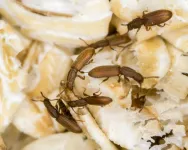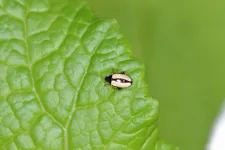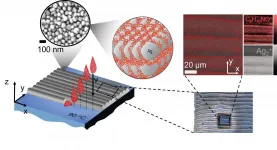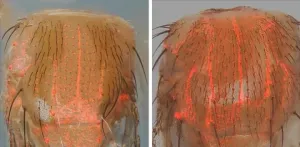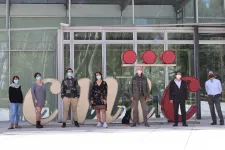(Press-News.org) Saw-toothed grain beetles live in a symbiotic association with bacteria. Their bacterial partners provide important building blocks for the formation of the insect's exoskeleton, which protects the beetles from their enemies as well as from desiccation. In a new study, a team of scientists from the Johannes Gutenberg University in Mainz, the Max Planck Institute for Chemical Ecology in Jena, and the National Institute of Advanced Industrial Science and Technology in Japan demonstrates that glyphosate inhibits the symbiotic bacteria of the grain beetle. Beetles exposed to the weedkiller no longer receive the building blocks they need from the bacteria. The study shows that glyphosate has the potential to harm insects indirectly by targeting their bacterial partners and thus to contribute to their decline (Communications Biology, doi: 10.1038/s42003-021-02057-6, May 2021).
Insects need microbial partners to survive
Organisms exist not in isolation but in an intricate network of ecological interactions. These interactions must be kept in mind when judging the impact of human activities. Insects in particular benefit in diverse ways from microbial symbionts, mostly via supplemented nutrients and chemical defenses. However, the benefits derived from such symbiotic associations may also make the insect more vulnerable. Insect hosts often become so reliant on their microbial partners that they can hardly survive alone. Without symbiosis, insects' development may be delayed or prevented, their susceptibility to natural enemies may be increased, their reproductive potential and competitiveness with conspecifics may be impaired, or they may die.
Glyphosate prevents symbiotic bacteria from providing the building blocks for the insect exoskeleton
Glyphosate is currently one of the most widely used pesticides in agriculture, despite increasing controversy about its potentially harmful side-effects. It is supposed to selectively suppress the growth of plants by inhibiting the biosynthesis of aromatic amino acids via the so-called shikimate pathway, a metabolic pathway occurring in plants and many microorganisms. Animals, on the other hand, do not encode the shikimate pathway, and thus are thought to be unharmed by glyphosate. However, many animals engage in mutualistic interactions with symbiotic microbes that rely on the shikimate pathway to produce amino acids required by these animals. "An impact of glyphosate on animals via their essential bacterial partners that use or even specialize in the shikimate metabolic pathway seems obvious, once the interaction of both partners is understood," explains Tobias Engl, one of the lead authors of the study. Glyphosate has already been shown to negatively affect microorganisms in the gut of honeybees, making the bees more susceptible to various stress factors. Furthermore, mutualistic bacteria across several herbivorous insect taxa provide a core benefit: the aromatic amino acid tyrosine needed for the biosynthesis of the insect exoskeleton (cuticle). This dependence on the symbiosis, in turn, may render insect herbivores particularly vulnerable to glyphosate in agriculture: The herbicide inhibits the shikimate pathway in their symbiotic bacteria and, as a result, important amino acids needed for cuticle formation are missing.
Is dependence on their symbiotic partners the Achilles heel of insects?
In the current study, the scientists show that glyphosate negatively influences the mutualistic bacteria harbored by the saw-toothed grain beetle Oryzaephilus surinamensis, an economically important pest of stored grain products. Exposure to the herbicide completely abolished the mutualistic benefit that symbiotic bacteria provide for the formation of the cuticle, an insect's primary protection against stresses, such as drought or predator attack.
The researchers sequenced the genome of the symbiont associated with O. surinamensis. The tiny symbiont genome (300 kbp) contains the genetic instruction for a metabolism specialized on the synthesis of aromatic amino acids via the shikimate pathway. Interestingly, the genome strongly resembles that of the bacterial partners of the palm weevil, which are also involved in cuticle formation, although these symbionts belong to a different group of bacteria.
"Finding a functionally equivalent symbiotic relationship that arose independently in two different bacteria phyla and distantly related beetle families highlights the importance of cuticle-supporting symbioses in beetles," says Julian Kiefer, the study's first author. The scientists tested the functional benefits for the host experimentally by supplementing the beetles' diet with aromatic amino acids, thus compensating for the elimination of their symbionts. Conversely, glyphosate exposure inhibited the establishment of the symbiotic bacteria throughout the beetle's development and abolished completely the mutualistic benefit for cuticle synthesis.
"When we observed the detrimental impact of glyphosate exposure on this symbiotic association, we wondered whether glyphosate poses a general threat to insects that depend on their microbial partners," explains Engl. By using phylogenetic analyses, the authors demonstrate that many obligate mutualistic bacteria associated with various different insect hosts indeed encode a glyphosate-sensitive enzyme in the shikimate pathway, suggesting that the susceptibility of its microbial symbionts to glyphosate represents an Achilles heel for an insect.
We are currently experiencing insect decline on a massive scale. Insect abundance is decreasing, as is insect diversity, not to mention the impact of the disappearance of bees, beetles and other insects at higher levels in the food chain. The new findings highlight the fact that the use of the herbicide glyphosate in agriculture endangers vital symbiotic relationships between insects and microorganisms and thus poses a serious threat to our ecosystems.
INFORMATION:
When horseradish flea beetles feed on their host plants, they take up not only nutrients but also mustard oil glucosides, the characteristic defense compounds of horseradish and other brassicaceous plants. Using these mustard oil glucosides, the beetles turn themselves into a "mustard oil bomb" and so deter predators. A team of researchers from the Max Planck Institute for Chemical Ecology in Jena, Germany, has now been able to demonstrate how the beetle regulates the accumulation of mustard oil glucosides in its body. The beetles have special transporters in the excretory system that prevent the excretion of mustard ...
Inks containing metal nanoparticles are among the most commonly-used conductive materials for printed electronics. Ink-jetting layers of MNP materials allows for unpreceded design flexibility, rapid processing and 3D printing of functional electronic devices such as sensors, solar panels, LED displays, transistors and smart textiles.
Inkjet 3D printing of metals typically form a solid printed object via a two-step process: solvent evaporation upon printing (pinning) and subsequent low-temperature consolidation of nanoparticles (sintering). The low temperature is important as in many applications the nanoparticles are co-printed with ...
Researchers at the University of California San Diego have laid the groundwork for a potential new type of gene therapy using novel CRISPR-based techniques.
Working in fruit flies and human cells, research led by UC San Diego Postdoctoral Scholar Zhiqian Li in Division of Biological Sciences Professor Ethan Bier's laboratory demonstrates that new DNA repair mechanisms could be designed to address the effects of debilitating diseases and damaged cell conditions.
The scientists developed a novel genetic sensor called a "CopyCatcher," which capitalizes on CRISPR-based gene drive technology, to detect instances in which a genetic element is copied precisely from one chromosome to another throughout cells in ...
Researchers at the University of Bristol have discovered how microbes responsible for human African sleeping sickness produce sex cells.
In these single-celled parasites, known as trypanosomes, each reproductive cell splits off in turn from the parental germline cell, which is responsible for passing on genes. Conventional germline cells divide twice to produce all four sex cells - or gametes - simultaneously. In humans four sperms are produced from a single germline cell. So, these strange parasite cells are doing their own thing rather than sticking to ...
Every high-school physics student learns that sound and light travel at very different speeds. If the brain did not account for this difference, it would be much harder for us to tell where sounds came from, and how they are related to what we see.
Instead, the brain allows us to make better sense of our world by playing tricks, so that a visual and a sound created at the same time are perceived as synchronous, even though they reach the brain and are processed by neural circuits at different speeds.
One of the brain's tricks is temporal recalibration: ...
A novel technique for studying vortices in quantum fluids has been developed by Lancaster physicists.
Andrew Guthrie, Sergey Kafanov, Theo Noble, Yuri Pashkin, George Pickett and Viktor Tsepelin, in collaboration with scientists from Moscow State University, used tiny mechanical resonators to detect individual quantum vortices in superfluid helium.
Their work is published in the current volume of Nature Communications.
This research into quantum turbulence is simpler than turbulence in the real world, which is observed in everyday phenomena such as surf, fast flowing rivers, billowing storm clouds, or chimney smoke. Despite ...
Scientists at the Centro Nacional de Investigaciones Cardiovasculares Centro de Biología Molecular Severo Ochoa (CBM-CSIC-UAM) have discovered that the nitric oxide (NO) pathway is overactivated in the aortas of mice and patients with Marfan Syndrome and that the activity of this pathway causes the aortic aneurysms that characterize this disease.
The results of the study, published today in Nature Communications, reveal the essential role played by NO in Marfan Syndrome aortic disease and identify new therapeutic targets and markers of NO pathway activation that could be used to monitor disease status and progression.
Aortic aneurysm ...
A new paper in the Journal of the European Economic Association, published by Oxford University Press, indicates that distrust generated by a 2011 CIA-led vaccination campaign ruse designed to catch Osama Bin Laden resulted in a significant vaccination rate decline in Pakistan.
Using a local doctor, the US Central Intelligence Organization planned an immunization plan in Pakistan to obtain DNA samples of children living in a compound in Abbottabad where American authorities suspected Bin Laden was hiding in order to obtain proof of Bin Laden's location (because the presence of close ...
About 42% of rural school districts in the U.S. offered fully in-person instruction as of February, compared with only 17% for urban districts, according to a new RAND Corporation survey of school district leaders. The opposite pattern held for fully remote learning: 29% of urban districts offered fully remote instruction compared with 10% of rural districts and 18% of suburban districts.
The choice of in-person versus remote learning has important implications. Over a third of all U.S. school districts offering some form of remote instruction in early 2021 had shortened the school day, and a quarter had reduced instructional minutes.
"This survey shows how the choice of remote instruction has ramifications that extend beyond longstanding concerns about ...
Aqueducts are very impressive examples of the art of construction in the Roman Empire. Even today, they still provide us with new insights into aesthetic, practical, and technical aspects of construction and use. Scientists at Johannes Gutenberg University Mainz (JGU) investigated the longest aqueduct of the time, the 426-kilometer-long Aqueduct of Valens supplying Constantinople, and revealed new insights into how this structure was maintained back in time. It appears that the channels had been cleaned of carbonate deposits just a few decades before the ...
